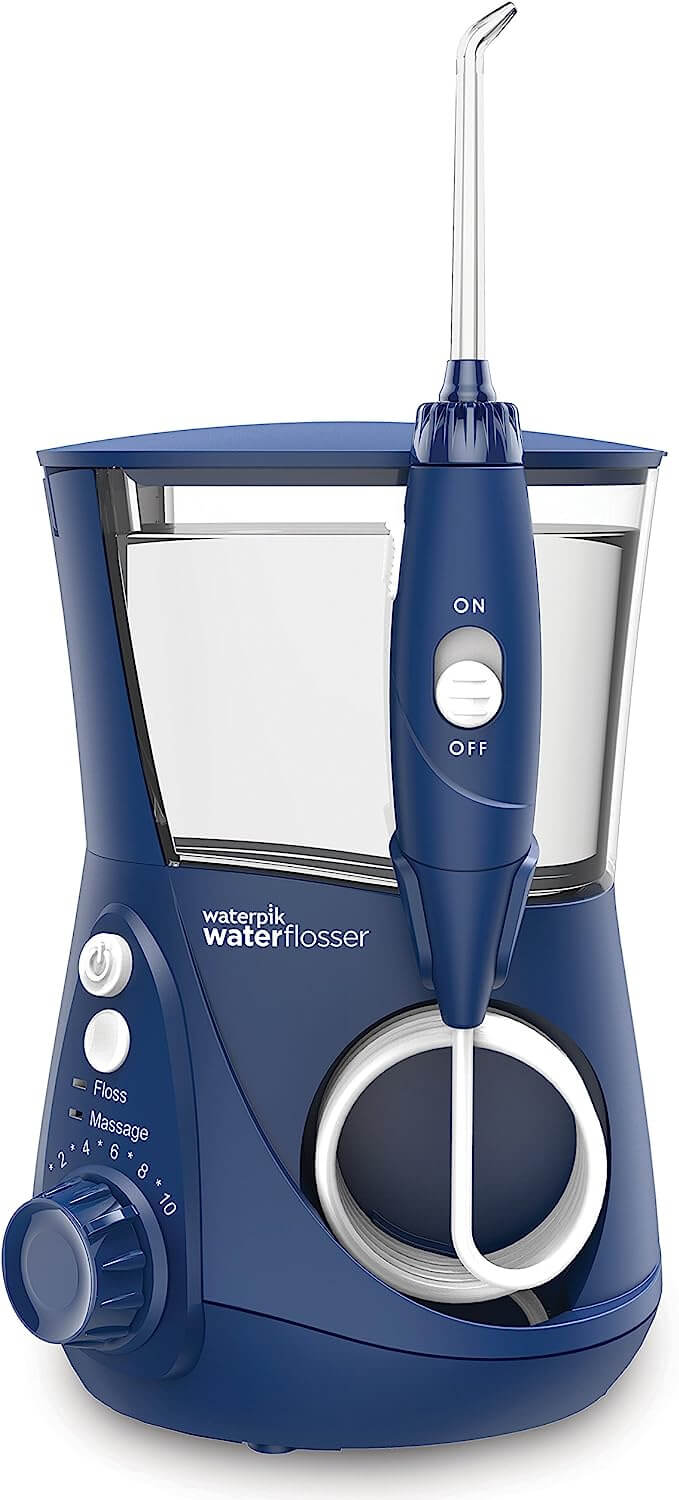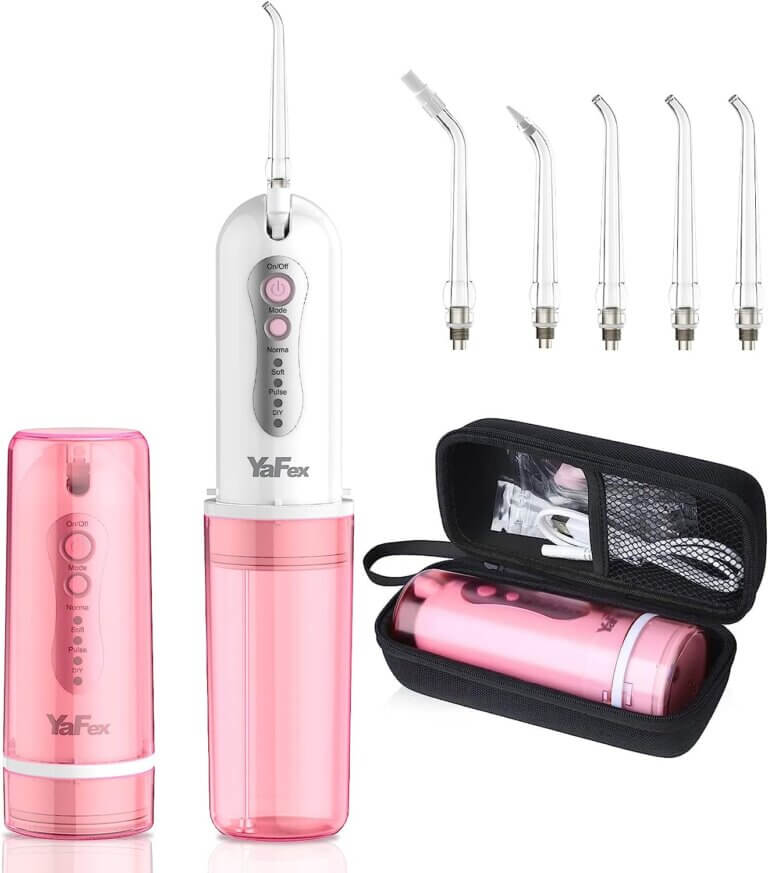How to Choose the Best Water Flosser for Your Dental Needs
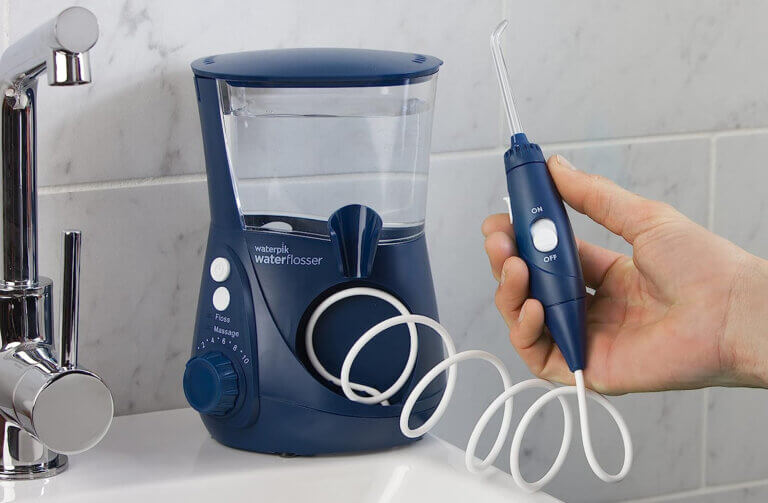
What Is A Water Flosser?
A Water Flosser, also known as an oral irrigator, is an electronic dental device that uses a stream of pressurized water to clean in between your teeth and along your gum line. It works by creating pulsating water pressure that can remove plaque and food particles that are difficult to reach with traditional dental floss or toothbrushes. Water flossers come in various sizes and shapes, from countertop models to portable cordless devices, and they typically come with different types of nozzles that can be used for different dental needs.
Water flossers are often recommended by dental professionals as an effective way to maintain good oral hygiene and prevent tooth decay and gum disease. They are especially helpful for people who have orthodontic braces, orthodontic retainer wires, dental crowns and dental bridges, dental implants, or other dental appliances. These dental appliances can make it more challenging to clean in between teeth and along the gum line. Using an Oral Irrigator can also be less painful and more comfortable compared to traditional dental floss, making it a popular option for those with sensitive teeth or gums. Before you visit your local pharmacy to buy a Water Flosser, there are some things you should know as a dental patient:
- Why Should I Use A Water Flosser?
- Proper Technique Using A Water Flosser
- How Often Should I Use A Water Flosser?
- Choosing The Right Type of Water Flosser
- Our Best Recommendations for A Water Flosser
- Alternatives to Using A Water Flosser
If you have questions about Water Flossers or if you need additional dental hygiene tips, please contact us for more information.
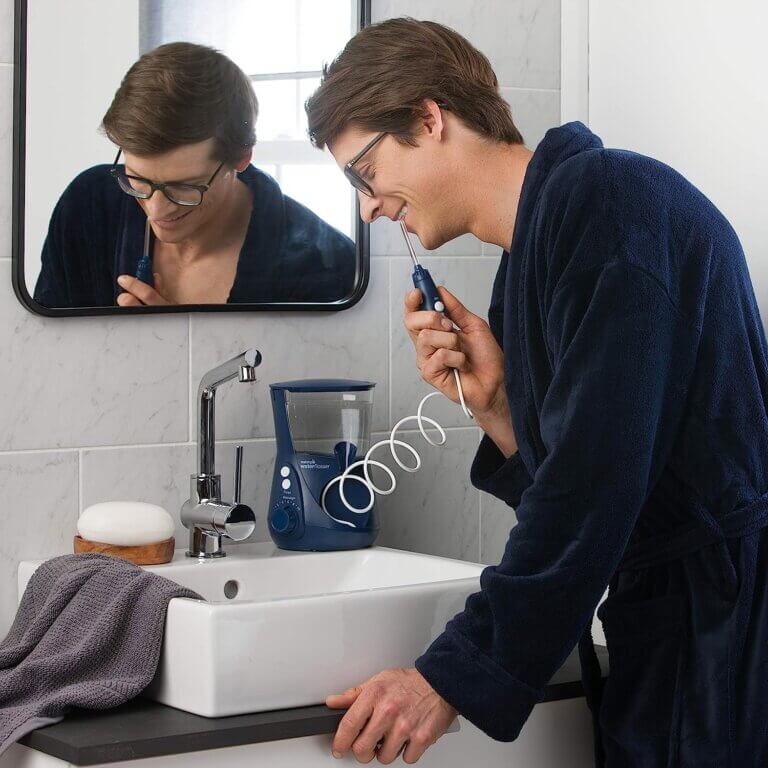
Why Should I Use a Water Flosser?
There are several reasons why you might want to consider using a Water Flosser as part of your oral hygiene routine:
- Effective Plaque Removal: A Water Flosser can help to remove up to 99.9% of plaque from treated areas, which can be very effective in combination with traditional dental flossing. The pulsating water stream can reach deep between teeth and along the gum line, where plaque tends to accumulate, and dislodge any debris or bacteria that may be hiding there.
- Reduced Bleeding and Inflammation: If you have sensitive gums that tend to bleed when you brush or floss, using an Oral Irrigator can be a gentler and more comfortable option. The pulsating water stream can help to massage and stimulate your gums, reducing inflammation and bleeding over time.
- Convenience and Accessibility: Water flossers are easy to use and can be more convenient than traditional flossing for some people. While string floss requires fine motor dexterity to manipulate the string between teeth, an oral irrigator requires just a push or a button. As long as you have access to an electrical outlet next to your bathroom sink, water flossers are a good option for people with mobility issues or dexterity problems who find traditional flossing difficult, and busy individuals who do not seem to have the patience to floss.
- Enhanced Dental Health: Using an Oral Irrigator as part of your daily oral hygiene routine can help to improve your overall dental health, reducing the risk of cavities, gum disease, and other dental issues. It can also leave your teeth and gums feeling cleaner and fresher, giving you a brighter, healthier smile.
Proper Technique Using A Water Flosser
Using an Oral Irrigator is easy and straightforward, but there are a few tips and techniques that can help you get the most out of your device. Here’s a step-by-step guide to using a Water Flosser properly:
- Fill the Reservoir with Water: First, fill the reservoir of your Oral Irrigator with warm water, according to the manufacturer’s instructions. You can also add mouthwash or dissolve some saltwater to the water for an extra fresh feeling.
- Choose the Right Tip: Select the appropriate tip for your dental needs. Some Water Flossers come with different types of tips, such as standard tips for general use, orthodontic tips for people with braces, orthodontic retainer wires, or other dental appliances, or gum massage tips for people with sensitive gums.
- Adjust the Pressure: Adjust the pressure setting on your Water Flosser according to your comfort level. If you are new to using a Water Flosser, start with a low pressure setting and gradually increase it over time as your gums get used to the sensation.
- Lean Over the Sink: Lean over the sink and place the tip of the Water Flosser in your mouth. Close your lips around the tip to prevent water from splashing.
- Aim the Tip: Aim the tip of the Oral Irrigator at a 90-degree angle to your teeth and gum line. Start at the back of your mouth and work your way forward, making sure to clean between each tooth and along the gum line. It is easy to let the water splatter all over your bathroom vanity, so make sure to keep your mouth closed around the flosser tip and use it over the bathroom sink so that the water falls down into the tub.
- Spit and Rinse: Spit out the water and debris into the sink as you floss. When you’re finished, rinse your mouth with water or mouthwash to remove any remaining debris or bacteria.
- Clean the Device: Empty the remaining water from the reservoir and be sure to follow the manufacturer’s instructions with respect to cleaning the device. This is to prevent any bacteria or buildup from forming over time.
By following these proper techniques, you can ensure that you are using your Water Flosser effectively and getting the most out of this valuable dental tool.
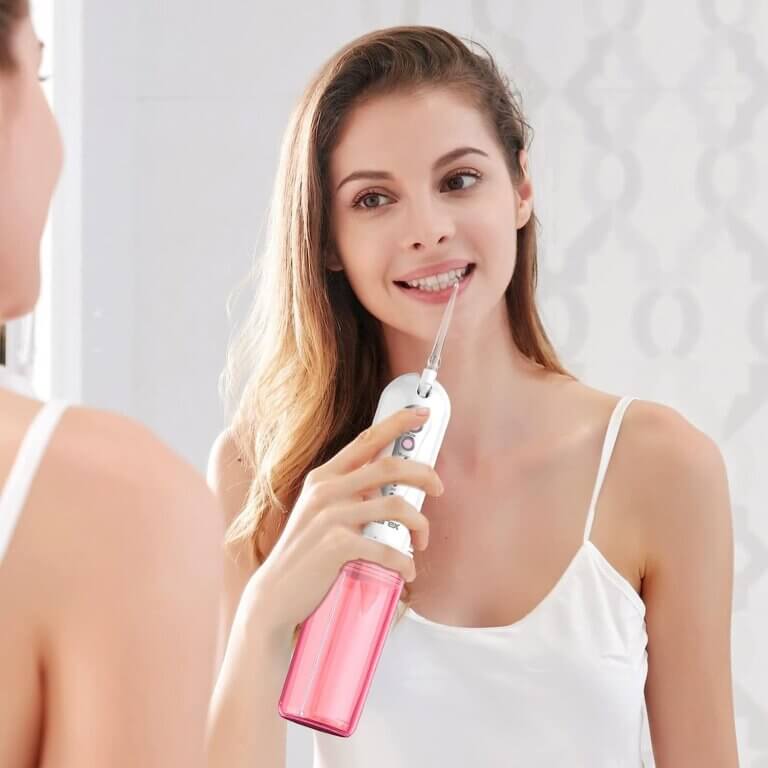
How Often Should I Use A Water Flosser?
Using a Water Flosser can be an effective way to remove plaque and improve gum health, but how often should you be using it? The answer depends on your individual dental needs and habits.
- Daily Use: For most people, using an Oral Irrigator once a day is sufficient to maintain good oral hygiene. This can be done in conjunction with brushing twice a day and regular dental checkups and cleanings.
- Consider Your Dental Needs: However, if you have specific dental needs, such as orthodontic appliances or a history of gum disease, your dentist may recommend using a Water Flosser more frequently. People with braces, for example, may need to use a Water Flosser after every meal to remove food particles and debris from around their brackets and wires.
- Start Slowly: If you’re new to using a Water Flosser, it’s important to start slowly and gradually increase your usage. Begin by using it once a day, and then you can increase the frequency as your gums become accustomed to the sensation.
- Be Consistent: Consistency is key when it comes to using an Oral Irrigator. Incorporate it into your daily routine and make it a habit to use it at the same time each day. This can help to ensure that you’re getting the maximum benefit from your Water Flosser.
- Consult with Your Dentist: If you’re unsure how often to use a Water Flosser, or if you have any concerns about your dental health, talk to your dentist. They can provide guidance on how to incorporate a Water Flosser into your oral hygiene routine and recommend the best type of device for your individual needs.
Choosing The Right Type of Water Flosser
There are several types of Water Flossers available on the market, each with its own unique features and benefits. Here are some factors to consider when choosing the right type of Water Flosser for your individual needs:
- Corded or Cordless: One of the first things to consider is whether you want a corded or cordless Oral Irrigator. Corded models need to be plugged into an electrical outlet and typically have more powerful water pressure and in our experience, they generally last longer and have fewer problems. In comparison, cordless models run on rechargeable batteries and while they are more portable, the useful life of these models tend to be shorter because the battery becomes weaker over time.
- Water Tank Size: The size of the water tank is another important factor to consider. A larger water tank means that you can floss for longer without needing to refill, but it also means that the device may be bulkier and harder to maneuver.
- Water Pressure Settings: Most Water Flossers come with adjustable water pressure settings, which allow you to customize the pressure to your individual needs. This is particularly important if you have sensitive gums or are new to using a Water Flosser.
- Additional Features: Some Oral Irrigators come with additional features, such as specialized tips for cleaning around braces, orthodontic fixed retainers or dental implants, or massage modes for stimulating gum health. Consider which features are important to you and whether they justify the higher cost.
- Price: Finally, price is a key factor to consider when choosing a Water Flosser. While more expensive models may come with additional features and higher quality materials, they may not be necessary for everyone. Determine your budget and choose a Water Flosser that meets your needs without breaking the bank.
By considering these factors, you can choose a Water Flosser that is tailored to your individual needs and preferences.
Our Best Recommendations for Water Flosser
With so many options available on the market, it can be difficult to choose the best Water Flosser for your needs. To help narrow down your search, here are some of our top recommendations for Oral Irrigators:
The Waterpik Aquarius Water Flosser is the best all-around water flosser for improving your oral health. With its advanced technology and sleek design, this water flosser effectively removes up to 99.9% of plaque from treated areas. The Aquarius features 10 pressure settings, 7 water flossing tips, and a convenient on/off switch on the handle, making it easy to customize your flossing experience. Its large 650 mL reservoir allows for 90 seconds of uninterrupted use, while the LED display shows the current pressure setting and remaining flossing time. With a compact and quiet design, the Waterpik Aquarius Water Flosser is perfect for use at home or on the go. Choose the best all-around water flosser for your oral health and try the Waterpik Aquarius Water Flosser today.
The YaFex Portable Oral Irrigator is the best travel-sized water flosser for maintaining your oral health on the go. With its compact and lightweight design, this water flosser is easy to pack and take with you wherever you go. Despite its small size, it features a powerful water pressure that can effectively remove food debris and plaque from hard-to-reach areas. The YaFex Portable Oral Irrigator features a 300 mL water tank that can provide up to 60 seconds of continuous use. Its rechargeable battery provides up to 2 weeks of use on a single charge, making it perfect for travel. With its 3 pressure modes and 4 jet tips, this water flosser is versatile and customizable to your oral hygiene needs. Additionally, its IPX7 waterproof rating ensures that it is safe to use in the shower or bath. Choose the best travel-sized water flosser for your oral health and try the YaFex Portable Oral Irrigator today.
Alternatives to Using a Water Flosser
While Water Flossers are a great tool for cleaning between teeth and improving oral hygiene, they are not the only option available. Here are two popular alternatives:
- String Floss: String floss is a tried-and-true method for removing plaque and food particles from between teeth. It is inexpensive and widely available, and can be used anywhere, without the need for a power source or water supply. To use string floss effectively, wrap it around your fingers and gently guide it between your teeth, making sure to curve it around the base of each tooth in a C-shape. Gently move the floss up and down to remove any debris.
- Interdental Brushes: Interdental brushes are small brushes designed to fit between teeth and clean the hard-to-reach areas that regular toothbrushes can’t. They come in various sizes to fit different gaps between teeth and can be a great option for those with braces, orthodontic retainer wires, dental implants, or other dental appliances. To use an interdental brush, gently insert it between your teeth and move it back and forth in a circular motion to remove any debris.
While Oral Irrigators, string floss, and interdental brushes are all effective at removing plaque and food particles, each has its own advantages and disadvantages. It’s important to choose the method that works best for you and to use it consistently as part of your daily oral hygiene routine.

